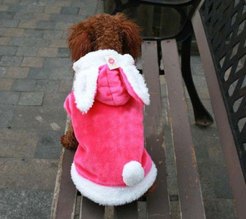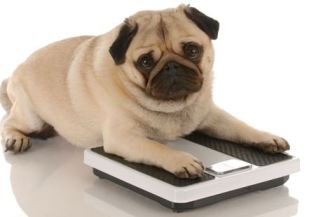~ Oh Happy Weekend! ~

~ Oh Happy Weekend! ~

 Proper grooming requires the right brush for your dog’s coat. Although there are many different shapes and sizes, there are basically three different brush types.
Proper grooming requires the right brush for your dog’s coat. Although there are many different shapes and sizes, there are basically three different brush types.
Bristle Brush
Bristle brushes come in a wide variety of styles. A bristle brush is best used on short-coated dogs for everyday grooming and to remove surface dust and dirt. On a long-coated dog a bristle brush can be used to finish the coat and bring out its natural luster and shine. Longer, widely-spaced bristles are better for dogs with longer coats, while shorter, tightly-packed bristles are made for short-haired dogs.
Pin Brush
Pin brushes have metal bristles set in a flexible rubber base. They are available in different pin lengths for a variety of coat lengths, textures and fullness. Pin brushes work well on dogs with medium to long hair or those with silky, curly, or woolly coats. Flexible pin brushes are also perfect for pets with thin coats and/or sensitive skin. Pin brushes work great to separate and untangle. Make sure you get a brush that has polished pins or coated pins so the brush doesn’t scratch and irritate your dog’s skin.
Slicker Brush
Slicker brushes have fine wire bristles with pins that are bent at an angle approximately halfway down the pin. Slicker Dog Brushes are available in a variety of sizes and degrees of pin stiffness. The heavier and thicker the coat, the stiffer the pins should be.
A slicker dog brush is usually used on long-coated dogs and are especially useful for removing mats and tangles.
Useful for combing out hair after detangling. There are different designs depending on your breed’s size and coat length. Medium/Coarse Combs are for breeds with medium-length hair or a coat that may require a gentle touch.
Source: http://www.doghows.com/grooming/choosing-the-right-brush-for-your-dog.html
 As Valentine’s Day approaches, you are probably trying to decide on the perfect gift for your dog. But did you know that the traditional tokens of affection — roses, chocolates, and other candies — can be harmful for the four-legged loves of your life? Here’s some tips to ensure a loving and safe Valentine’s Day this year.
As Valentine’s Day approaches, you are probably trying to decide on the perfect gift for your dog. But did you know that the traditional tokens of affection — roses, chocolates, and other candies — can be harmful for the four-legged loves of your life? Here’s some tips to ensure a loving and safe Valentine’s Day this year.
Don’t Let Your Animals Eat Chocolate
Chocolate, a popular gift around this time of year, can be dangerous to pets. A ten pound dog can come away with vomiting/diarrhea, hyperactivity, seizures and an abnormally elevated heart rate from just two ounces of baking chocolate or 20 ounces of milk chocolate. Cats are sensitive, too, but they don’t normally eat large enough amounts of chocolate to cause anything worse than gastrointestinal upset. Chocolates also contain fat and caffeine-like substances known as methylxanthines, which can potentially cause the above symptoms and, in severe cases, death.
Put Alcoholic Beverages Safely Away
Many a curious pet has explored an alcoholic beverage left in a glass. If ingested, this could cause vomiting, diarrhea, a lack of coordination, central nervous system depression, tremors, difficulty breathing, metabolic disturbances and coma. Alcohol can even cause death from respiratory failure if a large enough amount is ingested. It is important to keep in mind that animals are not only smaller than us, they often metabolize substances differently. This makes pets more susceptible to alcohol in smaller amounts. We advise not allowing pets to have any access to alcoholic beverages or other alcohol-based products.
Don’t Let Your Animals Ingest Sugar Substitute
Another potential hazard is gum or candy sweetened with the sugar substitute xylitol, which can cause a fairly sudden drop in blood sugar (known as hypoglycemia). This can result in depression, loss of coordination and seizures. “If you suspect your dog may have eaten products containing any of these harmful ingredients, please seek veterinary treatment immediately,” says Dr. Steven Hansen, veterinary toxicologist and Vice President of the ASPCA Animal Poison Control Center.
Keep Holiday Flowers Out of Reach
Many varieties of lilies are highly toxic to cats, so if these are your Valentine’s flower of choice, make sure your cats can’t get near them.
Other potentially poisonous flowers may include:
– tulips (especially if potted, as the bulbs are the most toxic)
– amaryllis (same as tulips)
– Calla lily (can cause intense oral and gastrointestinal irritation)
– daisies
– chrysanthemums
– baby’s breath
Safer alternatives might include:
– African violet
– asters
– camellia
– Canna lilies (they are not of the genus Lilium)
– jasmine
– orchids
Check out our toxic plant list to be sure that your choice of flower or plant is a safe one. Much of the information you’ll find there is pertinent for birds, as well as dogs and cats.
Keep Your Pets Away from Thorns
Pet owners are urged to take caution with roses and other flowers containing thorns, which could be potentially harmful to pets if played with, bitten, stepped on or swallowed. “It’s all too easy for pets to step on thorny stems that fall to the ground as a flower arrangement is being created,” says Dr. Louise Murray, Director of Medicine for the ASPCA’s Bergh Memorial Animal Hospital. “Be sure to keep your pets clear of your workspace as you arrange your beautiful flowers, since they can develop serious infections from thorn punctures.”
Don’t Leave Candles Burning
Candlelit dinners are romantic, just don’t leave the room while the flames are still burning. Let curious paws and beaks find other, safer things to play with.
Clean Up After Wrapping and Decorating
Make sure to keep balloons, cellophane, tape, ribbons, bows and other wrapping items or festive decorations out of your pets’ reach. Choking on any of these items, or ingesting them, may prove hazardous to your pet’s health.
The Right Way to Give Pets as Presents
It may seem very tempting to give your loved one a new puppy or kitten for Valentine’s Day. They sure are cute and cuddly! But the ASPCA wants to remind you that bringing a new companion animal into your home is a big decision. Why not present your loved one with a gift certificate to adopt from your local shelter, or take a trip to the shelter together? You might just make another love match.
Michelle Schenker since the day she was born, Michelle has lived in a home full of dogs and dog lovers. Her home is no exception with two adorable rescue pups of her own, Bella and Lily. Their unconditional love and never ending tail wags make every day brighter.
 Author: Laura Smith
Author: Laura Smith
Buying clothes for a dog might seem a bit strange to some people, but there are actually some very good reasons why you should consider splashing out on some stylish apparel for your pet. Coats, in particular, offer excellent protection from extreme weather and can help prevent some of the most common ailments that afflict this treasured companion, helping to keep down vets bills. At the same time, a quality coat can be a fantastic fashion accessory that gives a dog its own unique sense of style.
But what are the different types of dog coat available and what benefits do they bring? While there are a huge range of different coats available, covering a myriad of shapes, styles and sizes, you’ll find that dog coats generally fall into one of three general categories:
Waterproofs
Waterproof coats are essentially designed to keep dogs dry and sit quite comfortably on top of the animal. Regularly taking one out with you on rainy winter walks will stop your dog from bringing unwanted moisture into the house, meaning that you won’t have to worry as much about damp carpets or the dog rubbing itself against furniture to get dry.
A waterproof coat is also very beneficial for your pets health. Not only will it help prevent colds, its better for older dogs who suffer from joint pains. A dog that’s cold and damp from the rain will likely feel these pains flare up, so a waterproof coat could prove essential to keeping your dog happy.
Cold Weather Coats
Like waterproofs, these coats are intended to protect dogs from the adverse effects of miserable weather. However, cold weather coats go further in that they’re designed to keep the dog’s body heat at a normal level even in the coldest conditions. Quilted coats, for example, contain air pockets that trap the heat generated by the dog’s body, effectively insulating the dog and providing extra warmth. What’s more, these types of coat often feature attractive patterns or designs, meaning that they are the perfect marriage of fashion and function.
Hot Weather Coats
While you might think that a coat would be the last thing that a dog would want to wear in hot weather, they can actually be really beneficial. Long walks in the summer sun can leave dogs feeling dehydrated and exhausted. Cooling coats work by drawing the heat out of the dogs body, allowing regulation of body temperature that keeps the dog cool, calm and collected. This means that the dog will become far less agitated in hot conditions, which will make it happier and healthier in the long term.
As we can see, dog coats offer a number of benefits and are available to suit a range of situations. While your dog may at first resist his new coat and cause a fuss, you can be sure that the comfort these coats bring will make him or her appreciate it before long.
Laura Smith is a partner in The Waggy Tails Store, which sells dog accessories online and at country shows. Waggy Tails stock a range of dog coats, including Ancol dog coats for the cold and wet and Prestige cool dog coats for the height of summer.
Article Source: http://www.articlesbase.com/pets-articles/dog-coats-the-stylish-way-to-protect-your-dog-5813342.html
 Obesity in dogs is a growing concern in North America and it can lead to several diseases, such as diabetes, heart disease and arthritis. As you take time to give thanks and gather with friends and family to enjoy Thanksgiving feasts and festivities, please take a moment to consider your dog’s weight and how it impacts their health…before you spoil them with all those leftovers.
Obesity in dogs is a growing concern in North America and it can lead to several diseases, such as diabetes, heart disease and arthritis. As you take time to give thanks and gather with friends and family to enjoy Thanksgiving feasts and festivities, please take a moment to consider your dog’s weight and how it impacts their health…before you spoil them with all those leftovers.
How can you tell if your dog is obese?
Your dog is generally described as obese if he weighs 30% more than the ideal weight for his breed. With people, we typically use our height and weight to determine if we’re obese, but in dogs it’s a little different. Since there are so many different breeds and body types in dogs, “body scoring” is often used, in combination with weight charts, for determining obesity in dogs.
Here’s a simplified body scoring chart you can use to help you assess your dog’s weight:
What causes obesity in dogs?
Basically, obesity is an accumulation of excess energy that is stored in the body as fat. This happens when your dog takes in more calories than he expends, and it’s a bit of a vicious cycle. The more overweight or obese your dog is, the less active they tend to be and the less energy (calories) they’ll expend.
If you only feed your dog small amounts of food every day and you’re wondering why he’s overweight or obese, don’t forget about treats and table scraps. These treats can mean a lot of additional calories over time which can cause weight gain.
Hypothyroidism, a disorder in which the thyroid glands (which regular metabolism) are underactive, could also predispose your dog to obesity. If your dog is overweight, contact your veterinarian to test for hypothyroidism before starting a weight loss program.
What can you do to control your dog’s weight?
Thankfully, there are a lot of nutritional options and simple activities you can introduce to your dog to get their weight under control.
First things first, talk to your veterinarian. They’ll help you design a safe and effective weight loss program to meet your dog’s lifestyle.
With a nutritional plan established, it’s up to you to help your dog burn more calories. These activities can be simple – consider a brisk, 30 minute walk twice a day. The bonus here is that you’re also benefiting from the extra activity, too!
Weight reduction is typically 60% diet and 40% activity, and on both accounts it’s diligence and persistence that pay off. So be strong – while those cute puppy eyes are begging for treats, you need to remember that sticking to their nutritional plan is best for their health. Ask your veterinarian which treats you can use to spoil your dog, and how much you can give them. Just like people, portion control is important!
Source: http://algonquinanimalhospital.org/news/what-you-should-know-about-obesity-in-dogs